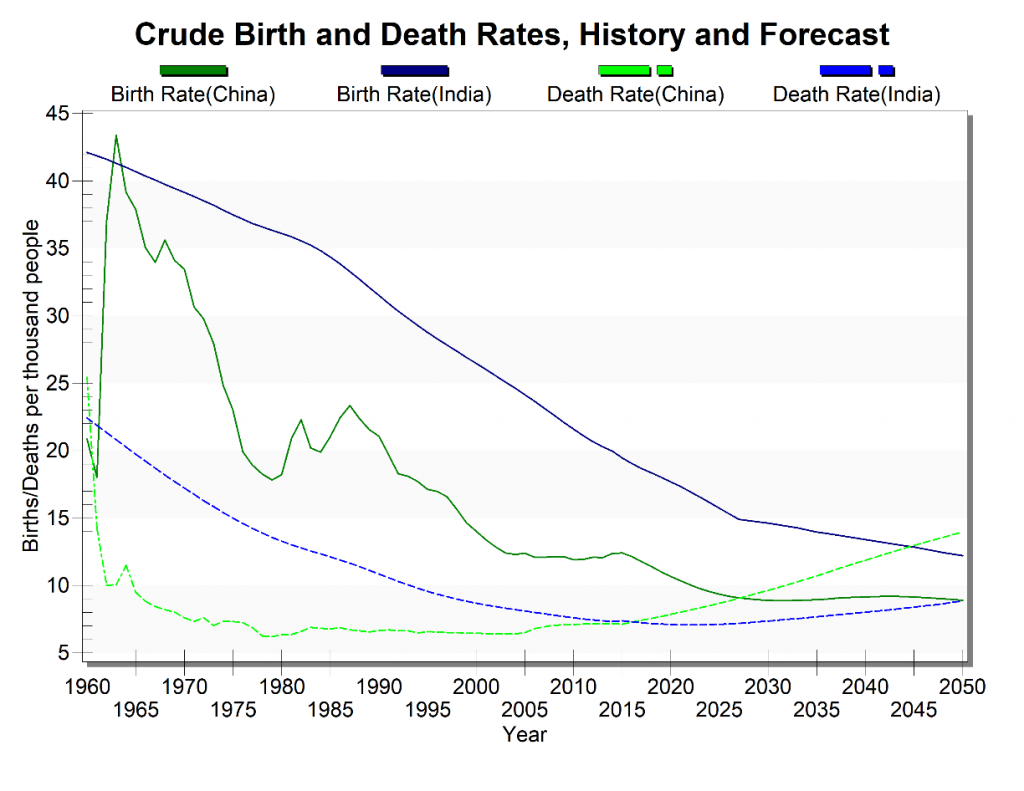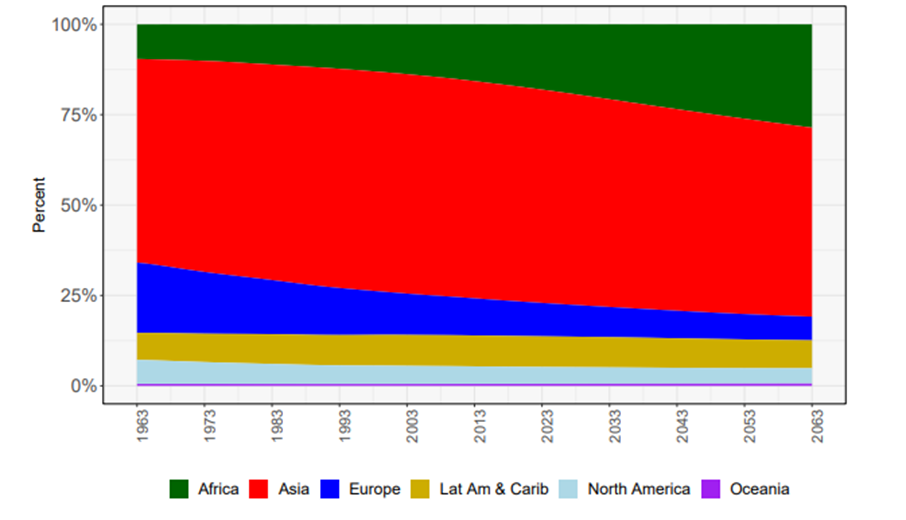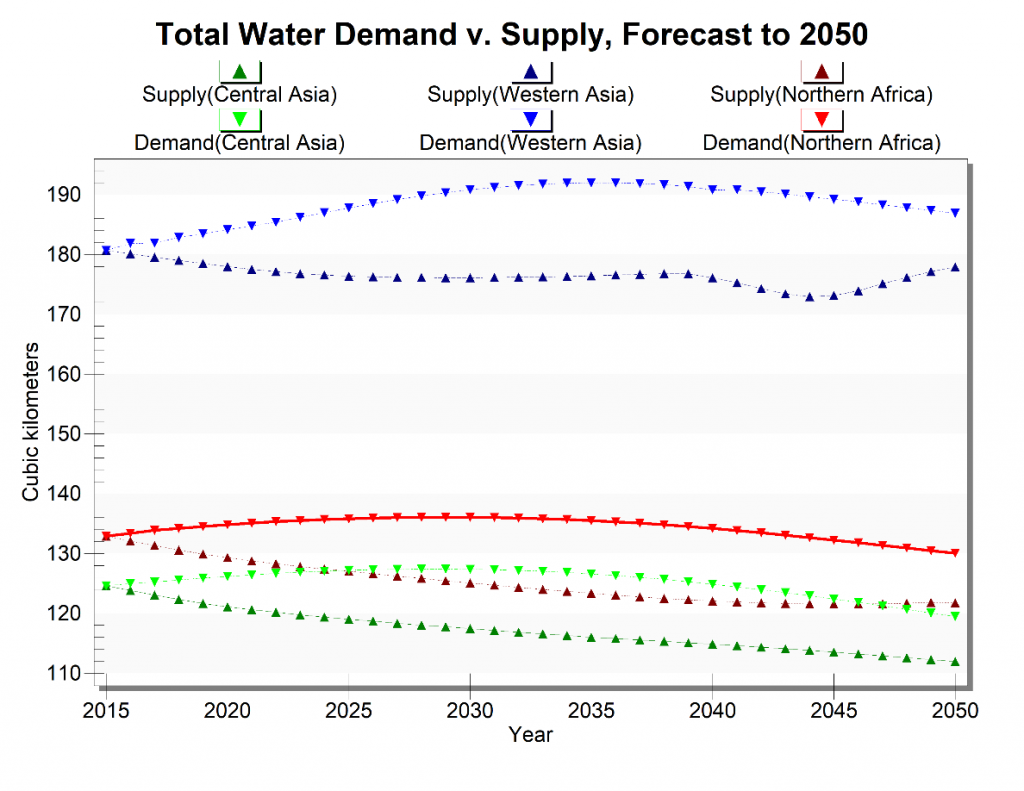[Editor’s Note: Mad Scientist Laboratory is pleased to publish today’s post by Collin Meisel and returning guest blogger Dr. Jonathan D. Moyer, both of the Frederick S. Pardee Center for International Futures. Eschewing another discussion of disruptive emergent technologies, Mr. Meisel and Dr. Moyer instead focus on persistent global trends that, while perhaps not as sexy as artificial intelligence or quantum computing, are just as relevant to warfighters preparing for competition and conflict with potential adversaries in the Future Operational Environment!]
 Too often, discussion of the Future Operational Environment (FOE) is filled with science fiction-inspired speculation of a world driven by the likes of quantum artificial intelligence (AI) and “self-constructing robotic ‘cyburgs’”. While these and similar potential technological developments are entertaining—and even useful to ponder—we should not let them distract us from less sensational but also consequential trends that are sure to transform the FOE in the coming decades, such as persistent demographic and economic shifts among great powers and the developing world. In other words, let’s take the “hype” out of hyperwar (i.e., a possible future where AI calls the shots on the battlefield).
Too often, discussion of the Future Operational Environment (FOE) is filled with science fiction-inspired speculation of a world driven by the likes of quantum artificial intelligence (AI) and “self-constructing robotic ‘cyburgs’”. While these and similar potential technological developments are entertaining—and even useful to ponder—we should not let them distract us from less sensational but also consequential trends that are sure to transform the FOE in the coming decades, such as persistent demographic and economic shifts among great powers and the developing world. In other words, let’s take the “hype” out of hyperwar (i.e., a possible future where AI calls the shots on the battlefield).
 For example, as a common feature of proposed hyperwar scenarios, quantum computing is often portrayed as both a force multiplier and boogeyman of the future despite its well-known fragility, stunted development, and potentially insurmountable limitations. Indeed, predictions of a soon-to-arrive quantum code-cracking menace are pure fiction. Similarly, despite predictions of the AI singularity—the hypothetical moment when AI surpasses human intelligence and subsequent advances presumably occur exponentially—AI, too, has its limitations.
For example, as a common feature of proposed hyperwar scenarios, quantum computing is often portrayed as both a force multiplier and boogeyman of the future despite its well-known fragility, stunted development, and potentially insurmountable limitations. Indeed, predictions of a soon-to-arrive quantum code-cracking menace are pure fiction. Similarly, despite predictions of the AI singularity—the hypothetical moment when AI surpasses human intelligence and subsequent advances presumably occur exponentially—AI, too, has its limitations.
Rather than speculating about what could become of these much-hyped technological developments, a more productive use of time is to consider, for example, the serious threat that more limited versions of quantum computing  and AI might still pose in, say, the hands of a declining China. Even as it rises, China is up against long-term, persistent trends—such as a forthcoming shrinking population and the predicament of aging before it gets rich—that are sure to impact geopolitics in East Asia and beyond as the Chinese Communist Party, which in part justifies its one-party rule by continued prosperity, clings to power. Indeed, this is a foreseeable, understandable future—the opposite of hype and speculation.
and AI might still pose in, say, the hands of a declining China. Even as it rises, China is up against long-term, persistent trends—such as a forthcoming shrinking population and the predicament of aging before it gets rich—that are sure to impact geopolitics in East Asia and beyond as the Chinese Communist Party, which in part justifies its one-party rule by continued prosperity, clings to power. Indeed, this is a foreseeable, understandable future—the opposite of hype and speculation.
 As another increasingly important geopolitical player, India faces its own set of structural shifts in a direction much different from that of China. With relatively high birth rates and lower death rates compared to China, India’s
As another increasingly important geopolitical player, India faces its own set of structural shifts in a direction much different from that of China. With relatively high birth rates and lower death rates compared to China, India’s  population will likely continue to rise—and, in part, drive economic growth—as its counterpart to the northeast begins to wither. While these forecasts are of one possible future, their consistency with trends over the last half-century suggests that policymakers in the United States and elsewhere should be preparing for such a world. And what of other persistent demographic trends? Although we cannot know for certain what Africa’s growth to nearly one-third of the world’s population by 2060 will mean in light of Europe’s simultaneous contraction, we can say with a fair degree of certainty that such a demographic shift is likely to happen given persistent global trends. Again, these are understandable futures; they are what is and has been happening, not hype.
population will likely continue to rise—and, in part, drive economic growth—as its counterpart to the northeast begins to wither. While these forecasts are of one possible future, their consistency with trends over the last half-century suggests that policymakers in the United States and elsewhere should be preparing for such a world. And what of other persistent demographic trends? Although we cannot know for certain what Africa’s growth to nearly one-third of the world’s population by 2060 will mean in light of Europe’s simultaneous contraction, we can say with a fair degree of certainty that such a demographic shift is likely to happen given persistent global trends. Again, these are understandable futures; they are what is and has been happening, not hype.

Using the freely-available, open-source International Futures tool, we and our colleagues at the Pardee Center for International Futures are working with the Army Future Studies Group (AFSG) to think about long-term futures by examining these and other persistent trends in areas ranging from  material power to natural systems. For example, AFSG fellows are asked to think about the planet’s water systems, impending water shortages across regions like Central and Western Asia and Northern Africa, and what they might mean for regional development and potential conflicts. While study of these less buzz-worthy trends may not tell the Army how it will be fighting wars of the future, it can at least help forecast trends that point to where and with whom.
material power to natural systems. For example, AFSG fellows are asked to think about the planet’s water systems, impending water shortages across regions like Central and Western Asia and Northern Africa, and what they might mean for regional development and potential conflicts. While study of these less buzz-worthy trends may not tell the Army how it will be fighting wars of the future, it can at least help forecast trends that point to where and with whom.
 Demographic transitions and shrinking aquifers may not have the same pizzazz as warfare at the speed of thought and other elements of the AI battlefield, but they possess equal potential to transform the FOE in fundamental ways. More importantly, these less sensational but persistent structural shifts can be considered in combination to develop plausible, understandable future scenarios—not science fiction fantasy. To be clear, hyperwar and its accompanying technologies still deserve attention, so long as those considering them do not get caught up in the hype. The goal of futures studies should be to strive towards a more understandable future—then we can worry about Elon Musk and the impending AI apocalypse.
Demographic transitions and shrinking aquifers may not have the same pizzazz as warfare at the speed of thought and other elements of the AI battlefield, but they possess equal potential to transform the FOE in fundamental ways. More importantly, these less sensational but persistent structural shifts can be considered in combination to develop plausible, understandable future scenarios—not science fiction fantasy. To be clear, hyperwar and its accompanying technologies still deserve attention, so long as those considering them do not get caught up in the hype. The goal of futures studies should be to strive towards a more understandable future—then we can worry about Elon Musk and the impending AI apocalypse.
If you enjoyed reading this post, please also see:
– Building Capacity to Think about the Future, by Drs. Jonathan D. Moyer and Christopher Rice and Mr. Alex Porter.
– Long Term Trends and Some Implications of Decreasing Global Interdependence, by Dr. Moyer, presented at the Mad Scientist Strategic Security Environment in 2050 Conference at Georgetown University, 8-9 August 2016.
– Extended Trends Impacting the Future Operational Environment, excerpted from the aforementioned Mad Scientist Conference’s final report.
– Emergent Global Trends Impacting on the Future Operational Environment, reviewing three additional sources that help us to understand new trends and technologies affecting the FOE.
– Making the Future More Personal: The Oft-Forgotten Human Driver in Future’s Analysis, by Mr. Andrew Sullivan, addressing the paramount disruptor — people and ideas.
… and crank up R.E.M.‘s It’s The End Of The World As We Know It (And I Feel Fine)!
Collin Meisel is a Research Associate at the Frederick S. Pardee Center for International Futures and a former U.S. Air Force Security Forces member.
Dr. Jonathan D. Moyer is Assistant Professor at the Josef Korbel School of International Studies at the University of Denver and Director of the Frederick S. Pardee Center for International Futures.



